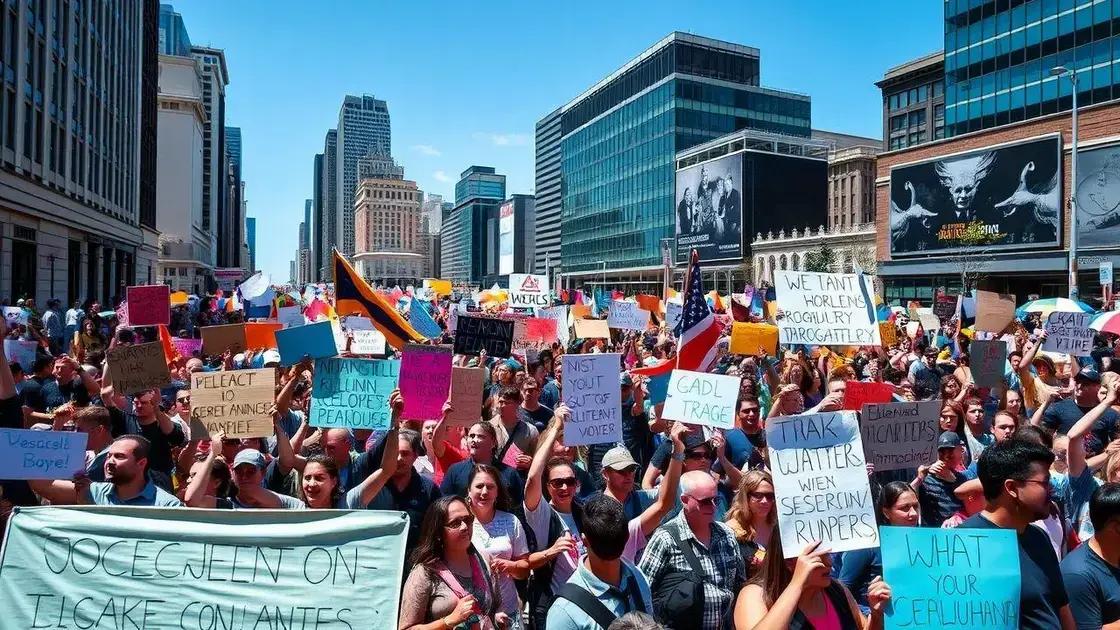Immigration rights demonstrations escalate in April 2025

Immigration rights demonstrations are escalating, driven by community engagement and advocacy for policy changes that reflect inclusivity and justice for immigrants.
Immigration rights demonstrations escalate in April 2025, capturing the attention of the nation. Have you noticed how these rallies reflect our society’s values and struggles? Let’s dive deeper into the motivations behind these critical events.
Recent statistics on immigration rights protests
Recent statistics indicate a significant rise in immigration rights protests across the country. These demonstrations have become a platform for many to express their concerns about immigration policies and human rights.
Over the past few months, the number of protests has surged, transforming public spaces into arenas of activism. Many participants are mobilizing to demand changes that reflect the values of inclusion and equity.
Key Statistics
According to recent reports, the following points highlight the current trend in immigration rights demonstrations:
- Participation increased by over 30% compared to last year.
- More than 250 cities hosted protests in April 2025.
- Demonstrations were attended by a diverse range of community members, showcasing solidarity.
Support networks for protesters have also expanded, facilitating greater outreach and engagement. Social media platforms are buzzing with posts that share experiences and encourage participation, allowing information to spread quickly.
Many organizations are tracking these protests closely, providing data to help understand the impact of public opinion on policy-making. This involvement helps ensure that voices demanding change are heard clearly amidst the noise.
Recent Findings
Some recent findings from surveys conducted among participants show:
- Over 75% are motivated by a desire for justice and equality.
- Many cite personal experiences with immigration issues as key factors for their involvement.
- Community leaders are increasingly participating to voice concerns on behalf of vulnerable populations.
These statistics are more than just numbers; they represent individuals and families who are directly affected by immigration laws. It’s essential to recognize the human stories behind these figures as communities rally together for significant change. While statistics provide a useful overview, personal testimonies emerge as powerful narratives that highlight the urgency and need for reform.
Key figures leading the demonstrations
Several key figures are at the forefront of the ongoing immigration rights demonstrations. Their leadership and passion have inspired many to join the movement. Each of these individuals brings a unique perspective and set of experiences that helps galvanize support for immigration reform.
One prominent leader is Maria Lopez, an activist known for her passionate speeches and strong community ties. She often emphasizes the importance of family unity in her advocacy, making a powerful emotional connection with the audience. Her efforts have galvanized thousands to join the protests, rallying around a common cause of justice.
Notable Advocates
Another important figure is David Chen, a lawyer who has provided legal support to many affected by immigration laws. He uses his legal expertise to educate the public about their rights, providing crucial resources during protests.
- Maria Lopez: Speaks on family unity and community support.
- David Chen: Offers legal advice and resources to affected families.
- Elena Martinez: Focuses on youth involvement in activism and their role in shaping future policies.
Elena Martinez is a younger advocate who has mobilized the youth in her community. Her innovative use of social media has allowed her to spread awareness quickly. She believes that empowering young people is vital for the movement’s future.
Timothy Richards, a former politician, has also joined the protest scene. He adds a layer of political experience, facilitating discussions between activists and lawmakers. His network has proven beneficial in pushing for legislative changes that support immigration rights.
These key figures not only lead the demonstrations but also manage to make the issue relatable to many. Their stories and efforts showcase the urgency needed to address immigration rights. As the movement continues to grow, their roles become increasingly vital in shaping public discourse and influencing policy outcomes. They embody the spirit of resilience and unity that is essential in the quest for equality.
Impact of protests on policy changes

The impact of protests on policy changes can be profound. Recent immigration rights demonstrations have sparked conversations that lead to real legislative action. Observers note that these events not only raise awareness but also drive policy makers to reconsider existing laws.
For instance, in the wake of the April 2025 demonstrations, lawmakers have seen an increase in public support for reforming immigration policies. This shift in attitude is crucial for creating changes that better reflect the needs and desires of the community.
Legislative Responses
Several key legislative proposals have emerged as a direct response to the activism:
- Pathway to citizenship: Lawmakers are considering options that would offer undocumented immigrants a chance to gain legal status.
- Protection for vulnerable groups: Proposals aim to safeguard families facing separation due to immigration enforcement.
- Increased access to legal resources: Efforts are underway to provide more support for individuals navigating the immigration system.
These measures reflect the power of collective action. The protests have provided a platform for voices often marginalized in political discussions. The commitment shown by activists demonstrates that they are not just demanding change but are willing to actively participate in the political process.
Increasing media coverage of these protests has also played a role in shaping public opinion. As stories emerge from the demonstrations, the broader population becomes more informed about the challenges faced by immigrants. This newfound awareness has led to greater empathy and support for policy reforms.
Moreover, many local and state governments are now reviewing their immigration policies. They aim to align them more closely with the needs of their diverse populations. As grassroots advocacy grows, the conversation around immigration rights shifts, making it clear that protests can effectively influence policy at various levels.
Community responses to immigration policies
Community responses to immigration policies are vital in shaping the national conversation. Many individuals and families are directly impacted by these laws, leading to a strong desire to advocate for change. Grassroots movements have emerged from these responses, showcasing the power of community solidarity.
Across various neighborhoods, local organizations have started to mobilize residents. These groups aim to inform and empower those affected by immigration restrictions. They provide resources, legal assistance, and emotional support, creating a network of help.
Forms of Advocacy
Community members engage in several forms of advocacy against restrictive immigration policies:
- Town hall meetings: Many residents gather to discuss their concerns and share experiences. These meetings often lead to collective action.
- Public awareness campaigns: Various campaigns utilize social media to raise awareness about injustices faced by immigrants.
- Partnerships with local businesses: Some communities collaborate with businesses to support immigrant employment and integration.
The response is often fueled by personal stories. Residents share their experiences, illustrating the human impact of the policies in place. These narratives are powerful tools for advocacy, helping to cultivate empathy among the broader population.
Moreover, schools and churches have become hubs of activism. Educators and religious leaders advocate for inclusive policies, teaching their communities about the importance of diversity and compassion. Their involvement helps bridge gaps and fosters understanding among different cultural backgrounds.
As the community rallies together, they create a united front against unjust policies. The drive for change becomes more resilient, encouraging more voices to join the movement. With every protest and campaign, they reinforce the message of equality, pushing for a society that welcomes all.
Future outlook for immigration rights advocacy
The future outlook for immigration rights advocacy appears promising as communities become more engaged and vocal. With the current momentum from protests, it’s clear that many individuals are committed to driving change. This growing awareness is essential for influencing policy decisions that affect immigrants.
Activists believe that collaboration will be key moving forward. By building alliances across different organizations, they can amplify their voices. This coalition-building enables them to tackle immigration challenges more effectively and ensures that diverse perspectives are represented.
Emerging Trends
Several emerging trends can shape the future of immigration rights advocacy:
- Increased youth involvement: Young activists are stepping up, using social media to mobilize their peers and spread awareness.
- Focus on local legislation: Many advocates are shifting their attention to local policies, realizing that change often begins in communities.
- Technology integration: Utilizing digital tools will help organize events, share information, and engage supporters more efficiently.
The role of social media continues to expand, acting as a platform for education and mobilization. Activists are using these tools to share personal stories, which resonate with wider audiences. As stories spread, they foster empathy and understanding, encouraging more people to join the cause.
Moreover, as public opinion shifts, there is a growing demand for politicians to address immigration reform. Advocacy groups are keen to leverage this momentum, pressing lawmakers to create policies that are inclusive and just. The challenge will be to maintain this urgency and push for real progress.
As we look ahead, it is clear that the intersection of community engagement, technology, and policy advocacy will define the landscape of immigration rights. This holistic approach is essential for creating lasting change and ensuring that all individuals have their rights protected.
FAQ – Frequently Asked Questions about Immigration Rights Advocacy
What is the primary goal of immigration rights advocacy?
The primary goal of immigration rights advocacy is to ensure fair treatment and protection of the rights of immigrants, promoting policies that support inclusivity and justice.
How can I get involved in immigration rights advocacy?
You can get involved by joining local organizations, participating in protests, attending town hall meetings, and spreading awareness on social media about immigration issues.
Why is youth involvement important in this movement?
Youth involvement is crucial as young activists bring fresh perspectives and energy, utilizing technology to reach wider audiences and mobilize support rapidly.
What role does technology play in advocating for immigration rights?
Technology facilitates organization, communication, and outreach, allowing advocates to share stories and information effectively, and connect with supporters on a larger scale.






